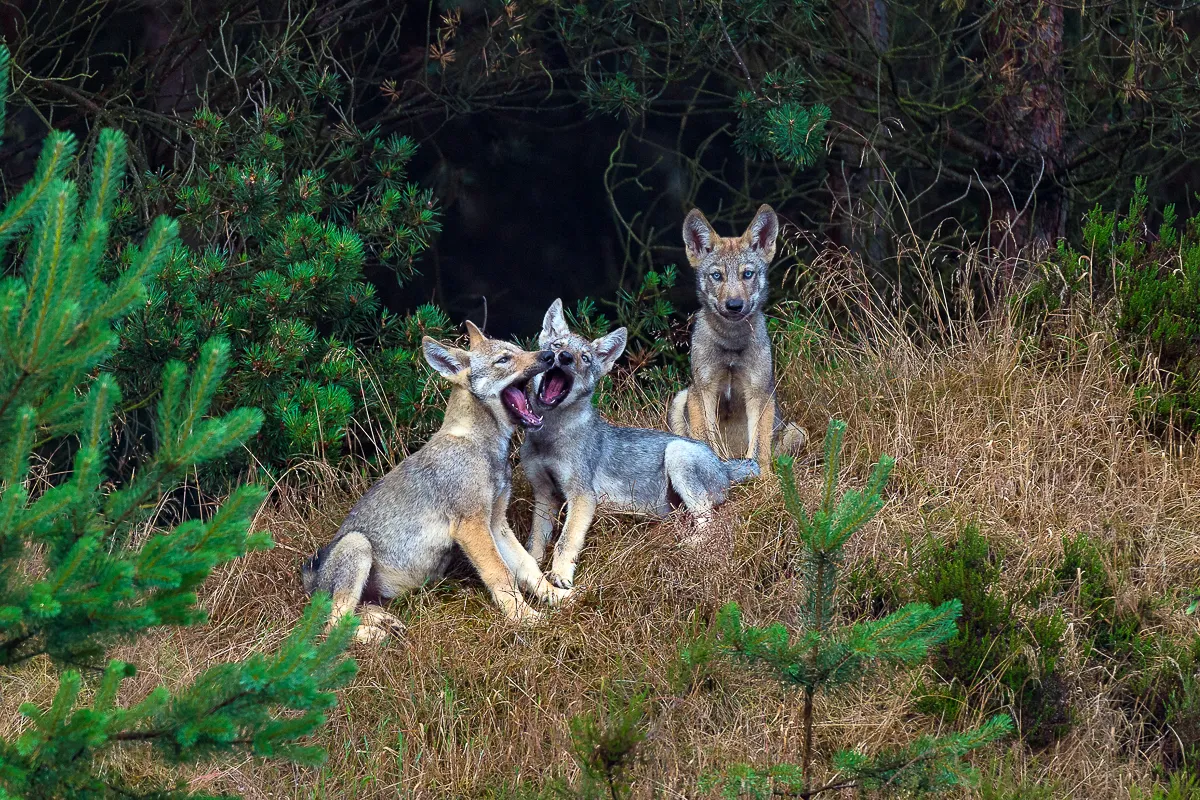It's 2009 and I'm sitting in a hide on a military training ground in Saxony, close to the Polish border, overlooking a wide, open sandy area. It acts as a firebreak between where I am and the dark forest beyond. The croaking of a raven echoes through the quiet air and a light wind rushes through the leaves.
There are no animals to be seen, yet the sandy ground is pitted with the tracks of roe and red deer, wild boar, foxes – and wolves. It may not be total wilderness, yet I am still in the heart of Germany’s wolf country.
I wait for some time, unmoving in the hide, and then suddenly it happens – the moment I’ve been waiting for. A wolf steps out of the trees and into the open, pausing to catch the scent of other forest-dwellers drifting on the breeze.
It’s my first encounter with a wild wolf in Germany and I can hardly believe my eyes. The wolf continues to sniff the air and draws closer and closer. Then it seems the wind carries my scent to him. After a brief moment of orientation, he immediately changes pace and direction, sprinting back into the dense forest. Apparently he is not keen on humans.
Once widespread in central Europe, wolves had almost been hunted to extinction by the 19th century, regarded as a danger to livestock, competitors for game and a threat to people, in whom fear of this species has long run deep. But 20 or so years ago, these predators started to come back – not through reintroduction but by naturally migrating west from Poland. In the years since, they have managed to not only reestablish themselves in Germany, but to steadily strengthen their hold, increasing their population by about 25 per cent annually.
I have enjoyed many more magical encounters with wolves since that memorable day 13 years ago, but it’s still difficult to learn about their behaviour. Most are very similar to that first individual I saw – nervous, edgy, retreating as soon as they sense the presence of humans – and many aspects of their biology remain poorly understood as a result.
Thankfully, by carrying out intensive wolf monitoring in Germany, researchers are trying to change this. The number of offspring, fatalities, kinship of packs and the way young wolves are dispersing are all now being studied to assess the health and social dynamics of the resurgent population.
When did wolves arrive back in Germany?
It was on this very training ground that, at the close of the 1990s, Germany’s first returning pair of wild wolves was confirmed. In 2000, the female gave birth to a litter of cubs. They were the first wild wolves to be born in the country in about 150 years.
You can easily see why the newcomers made themselves at home in the military zone. Off-limits to civilians, there is little disturbance (quiet areas can always be found away from booming guns and rattling tanks) and the wooded areas are rich in prey. For a wolf, it doesn’t really get much better.
How did wolves return to Germany?

Rumours spread that the wolves had been unofficially reintroduced, but genetic analysis has proved without any doubt that they arrived under their own steam. Today, Upper Lusatia, a region mostly located in Saxony, has a high wolf density, comprising many territories adjacent to each other. The population extends north-west to Hamburg, Berlin and beyond, with small satellite territories dotted in the west of the country.
Over the years, the few individuals fitted with radio collars have provided valuable data on movement and migration. One wolf travelled east, made its way through Poland and stayed in the border area between Belarus and Lithuania, clocking up a journey of about 800km as the crow flies from its home in Saxony. Indeed, wolves can travel great distances to find new territories, meaning a wolf could appear anywhere in Germany at any time.
Without radio collars, tracking down such elusive creatures is extremely challenging. Camera traps – the secret eyes of researchers – are indispensable to the cause, with hundreds deployed across Germany’s forests. Prints in the sand, on damp ground or in the snow also provide clues to the animals’ whereabouts, as does the presence of territorial scats.
According to the German Federal Agency for Nature Conservation (BfN), 161 wolf packs, 35 pairs and 22 solitary animals were confirmed in Germany in the monitoring year of 2021-22. In total, the population could number about 1,200 wolves. Nobody knows the exact number as these wide-ranging and secretive animals cannot be counted individually, and pack size can fluctuate between five and ten animals over the course of a year, but the number of territories is well known, so these figures are still good and as accurate as they can be based on scientific monitoring data.
With its wooded low mountain ranges, as well as the Alps and their surrounds, Germany has many regions that would be suitable for wolves that are yet to be repopulated. According to the BfN, there could be space for about 700–1,400 wolf territories in Germany. The animals can live in any area that is large enough and that offers suitable shelter and prey.
Axel Gomille is a zoologist, photographer and film-maker from Germany, focussing on wildlife and conservation. He has produced two books on Germany’s wild wolves. You can find out more at axelgomille.com/english.
Images ©Axel Gomille
